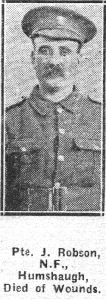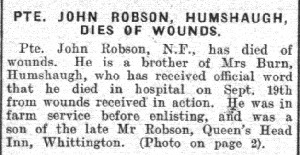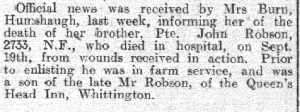
Hexham Courant 07/10/1916

Hexham Courant 07/10/1916

Hexham Courant 30/09/1916 1

Hexham Courant 30/09/1916 2
Mr. Phil Taylor has provided the following:
The Robson Family of Great Whittington had run the Robin Hood on the Military Road and lived and farmed at the Queen’s Head where John Robson, known as Jack died in 1914. His third son – John Robson born in 1881 - was working for Elizabeth Blackburn at Dukesfield Hall near Hexham in 1911.
The Hexham Courant 07/10/1916 carried news of his death in hospital from wounds in 1916 – mentioning his sister Mrs Burn of the Square in Humshaugh. This was Elizabeth Robson who had married Thomas Burn on New Year’s Eve at Corbridge 1903.
John had enlisted in the Northumberland Fusiliers and later became a member of the 150th Company of the Machine Gun Corps (Infantry).
150th Machine Gun Corps Frances 50th (Northumbrian) Division, 150th (York & Durham) Brigade and they were in action on the 16th Sep 1916 on the Somme in the Battle of Flers-Courcelette (15th-22nd September)
The 150th Machine Gun Company was formed in 150th (York & Durham) Brigade, 50th (Northumbrian) Division on the 1st of February 1916. They fought on the Somme at The Battle of Flers-Courcelette, The Battle of Morval and The Battle of the Transloy Ridges. In 1917 they were in action at Arras during The First Battle of the Scarpe, The Capture of Wancourt Ridge and The Second Battle of the Scarpe before moving north for the Third Battle of Ypres. They later joined with the other machine gun companies of the Division to form 50th Machine Gun Battalion on the 1st of March 1918.
Private John Robson age 35 was wounded and later died in hospital in France on September 19th 1916 and is buried in the St Sever Cemetery near Rouen. His name is recorded on the commemorative wooden plaque discovered in the Wesleyan Chapel at Great Whittington.
It is likely he died in one of the many Base Hospitals which were part of the casualty evacuation chain, further back from the front line than the Casualty Clearing Stations. They were manned by troops of the Royal Army Medical Corps, with attached Royal Engineers and men of the Army Service Corps. In the theatre of war in France and Flanders, the British hospitals were generally located near the coast, close to a railway line, in order for casualties to arrive (although some also came by canal barge); they also needed to be near a port where men could be evacuated for longer-term treatment in Britain.
There were two types of Base Hospital, known as Stationary and General Hospitals. They were large facilities, often centred on some pre-war buildings such as seaside hotels. The hospitals grew hugely in number and scale throughout the war and there were dozens in and around Rouen in 1916.
John Robson is remembered at Great Whittington on G15.01

